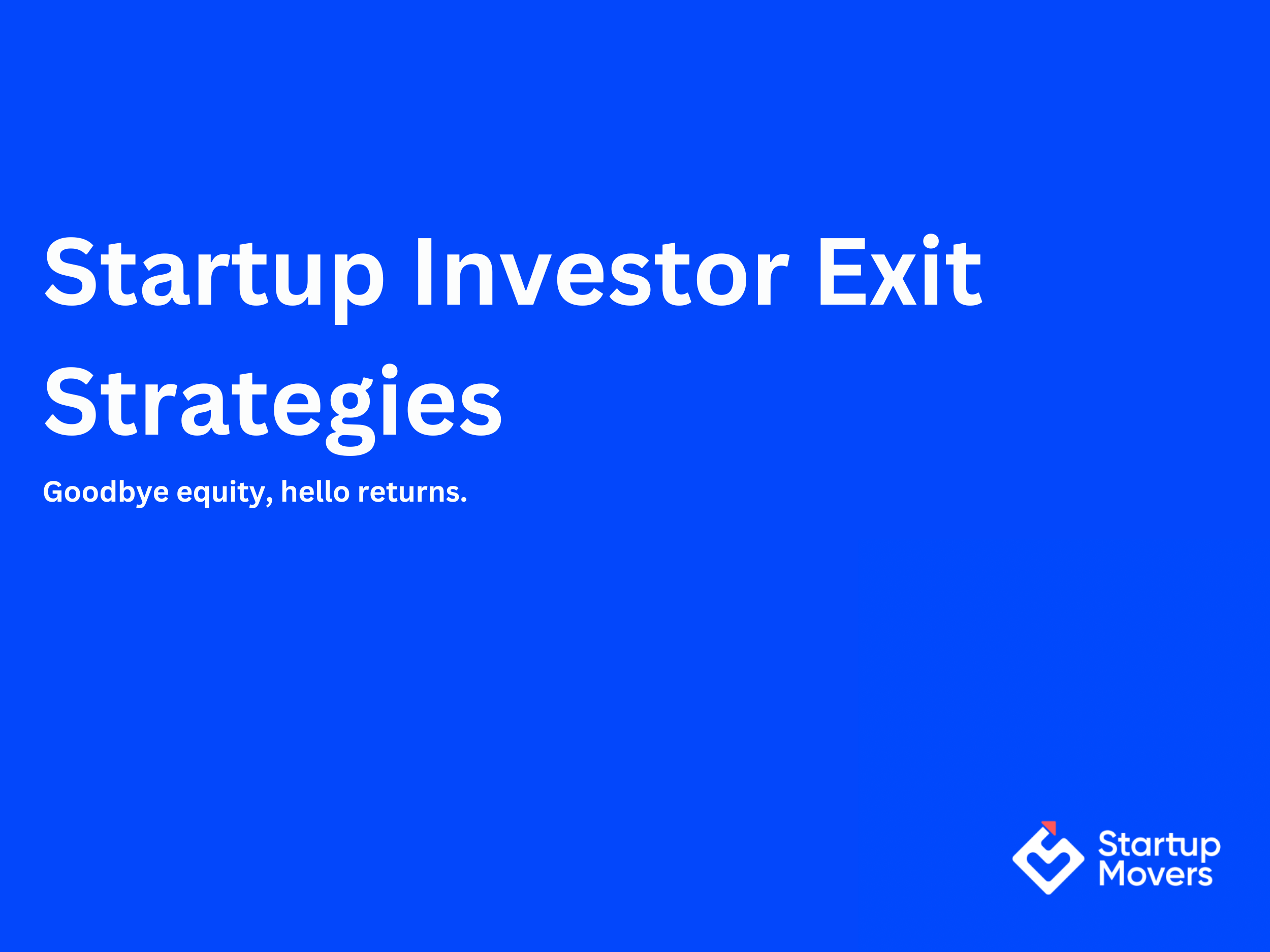Understanding Dilution: How Much Equity Should You Give Up in Fundraising




Exit strategies for investors are crucial for planning a profitable and timely departure from a startup. But many investors miss out because they don’t know when or how to exit smartly. The good news?
There are proven ways to cash out profitably, and it’s easier than you think.
Read on to discover the top exit strategies that help investors like you get the most from their startup bets.
When you invest in a startup, you’re not just hoping for it to grow; you want to know how you’ll eventually get your money back. That’s where exit strategies come in.
An exit strategy is a plan for how investors and founders can sell their shares or ownership in a startup to realize profits. It’s the roadmap for cashing out, whether through selling the company, going public, or other methods.
Knowing the right types of exit strategies helps you plan when and how to exit. Many investors think exits mean IPOs, but options include acquisitions, secondary sales, buybacks, and liquidation.
Understanding these, along with key startup valuation methods, will help you invest smarter and avoid costly mistakes.
The Risk-Return Balance
Every investment has two sides: entry and exit. For startup investors, having a solid exit strategy is critical.
According to Investopedia, about 90% of startups fail, often due to funding shortages or poor market fit. This makes a clear exit plan vital to protect your return on investment (ROI) and avoid losses.
Without an exit plan, your investment can get stuck in illiquid shares with no clear way out. This ties up your capital and limits your ability to pursue new opportunities.
Worse, you might have to exit at a loss or miss out entirely. Clear exit strategies also help entrepreneurs and investors align goals and reduce friction.
Investors usually expect returns within 5 to 10 years, but founders don’t always plan for exits early. This gap can cause tension and misaligned goals.
Discussing exit opportunities for startups upfront ensures everyone is on the same page and makes future decisions smoother.
Learn how to turn paper value into real profits.
Learn moreLet’s explore the main exit strategies investors like you use to turn startup stakes into real returns. Each has its pros, ideal scenarios, and real-world success stories.
1. Acquisition by a Larger Company
What it means:
A larger, more established company buys the startup, either to absorb its technology, talent, customer base, or eliminate competition.
Why it works:
This is one of the fastest and most profitable exit strategies for entrepreneurs and investors. It provides immediate liquidity, often at a premium valuation, especially if the acquiring company sees strategic value in the startup.
|
Real-life example: |
Best for:
Startups in tech, SaaS, and innovation-heavy industries with scalable solutions and strategic market presence. This is among the most desirable exit opportunities for startups, especially in sectors with aggressive M&A activity.
2. Initial Public Offering (IPO)
What it means:
The startup lists its shares on a public stock exchange, giving early investors the ability to sell their equity to public shareholders.
Why it works:
An IPO offers liquidity, prestige, and often significantly higher valuations. It’s a classic startup investor exit strategy that converts long-term equity into publicly tradable shares.
|
Real-life example: |
Best for:
Startups with strong revenues, market buzz, and a sustainable growth model. It’s one of the most high-profile types of exit strategies used when startups hit scale.
3. Secondary Sale of Shares
What it means:
Instead of waiting for an IPO or acquisition, investors sell their shares to other private investors, often during later funding rounds.
Why it works:
This offers an early exit and liquidity without waiting for the company to "go big." It's especially useful for angel investors who want to reduce exposure once institutional investors come in.
Use case:
Angel investors commonly use secondary sales to cash out once VCs enter with deeper pockets and longer investment horizons.
|
Real-life example: |
Best for:
This is a smart and flexible path for early-stage backers. An important part of modern exit strategies for entrepreneurs and investors is to stay agile.
4. Buyback by Founders
What it means:
Founders purchase investor shares, either directly or through company reserves, to regain equity control.
Why it works:
This is often a clean, controlled exit that benefits both sides; the founder gets back more ownership, and investors receive a negotiated return.
When it happens:
Typically seen in slower-growth but profitable startups, where an IPO or acquisition isn't imminent but liquidity is needed.
|
Real-life example: |
Best for:
In profitable startups with long-term goals and no immediate IPO/acquisition in sight. A lesser-known but powerful startup investor exit strategy, especially in non-VC-dependent ecosystems.
5. Liquidation or Asset Sale
What it means:
If a startup fails or cannot scale, its assets (like IP, technology, or equipment) are sold off, and proceeds are distributed among creditors and investors.
Why it works:
While it’s not ideal, this is a last-resort exit that can help recover a portion of your capital. It's better than a complete write-off.
Stat Insight:
CB Insights reports that 38% of startups fail due to a lack of cash. In such cases, liquidation offers a way to salvage some value.
|
Real-life example: |
Useful when:
There’s no path to scale or profitability, and the focus shifts to damage control. This is one of the more difficult exit opportunities for startups, but it remains a valid option in risk-heavy investments.
Let’s help you craft a well-timed, well-executed exit strategy.
Schedule a 1:1 callFactors to Consider When Choosing an Exit Strategy
Not all startup investor exit strategies are created equal. Your ideal exit depends on more than just profitability, it’s about timing, market dynamics, and your unique role as an investor.
Here’s what you need to weigh before making your move:
1. Stage of the Startup
Your exit path often hinges on where the startup is in its journey.
Knowing the growth phase helps you time your exit right.
2. Investor’s Role & Equity Stake
Your influence in the company directly affects your exit options.
The bigger your stake, the more say you have in how and when to exit. It’s also crucial for founders to design their ESOP policy thoughtfully, as this affects ownership distribution and can impact your exit opportunities.
3. Market Conditions
Market sentiment can make or break your exit window.
Stay attuned to macroeconomic signals and investor appetite.
4. Founder–Investor Alignment
Misalignment can derail even the most promising exit plan.
Discuss exit strategies for entrepreneurs at the term sheet stage, not the finish line.
A shared vision between founders and investors ensures smoother execution when it’s time to exit.
5. Legal & Tax Implications
Exits aren’t just financial decisions, they’re legal ones too.
Always work with legal and tax advisors to avoid post-exit complications.
How to Prepare for a Profitable Exit
A successful exit doesn’t happen by luck, it’s a result of careful planning and proactive decisions. To turn your stake into strong returns, start early and stay smart.
Here’s how you can prepare to exit profitably:
1. Set Clear Exit Goals Early
Clear communication sets the stage for mutually beneficial startup investor exit strategies.
2. Include Exit Clauses in Term Sheets
These clauses protect your interests during exit opportunities for startups, especially during acquisitions.
3. Monitor Performance & Valuation Closely
Being data-driven helps you choose the right types of exit strategies at the right time.
4. Stay Involved, But Exit-Focused
Balance support with detachment, so when the right exit moment comes, you’re ready to move.
By now, you know the landscape of startup investor exit strategies, from IPOs and acquisitions to secondary sales and buybacks. Each route comes with its timing, benefits, and risks.
The most successful investors? They prepare their exit at the same time they plan their entry.
Because without a plan to exit, equity is just theory, not returns.
We’ll show you how successful investors make it happen.
Book your FREE strategy callQ. What are the 5 exit strategies for startup investors?
Each has pros and cons depending on the startup’s growth and investor goals.
Q. What is an example of a successful startup exit strategy?
WhatsApp's acquisition by Facebook is a prime startup exit strategy example, with early investors seeing returns of over 50x.
Q. What are the best exit opportunities for startups in 2025?
In 2025, strong acquisition activity, growing secondary markets, and late-stage IPOs are trending.
Investors are increasingly exiting through VC-led secondaries due to volatile public markets.
We’ve helped hundreds of investors exit smartly, you could be next.
Get your custom exit plan

Leave a Comment
Comments